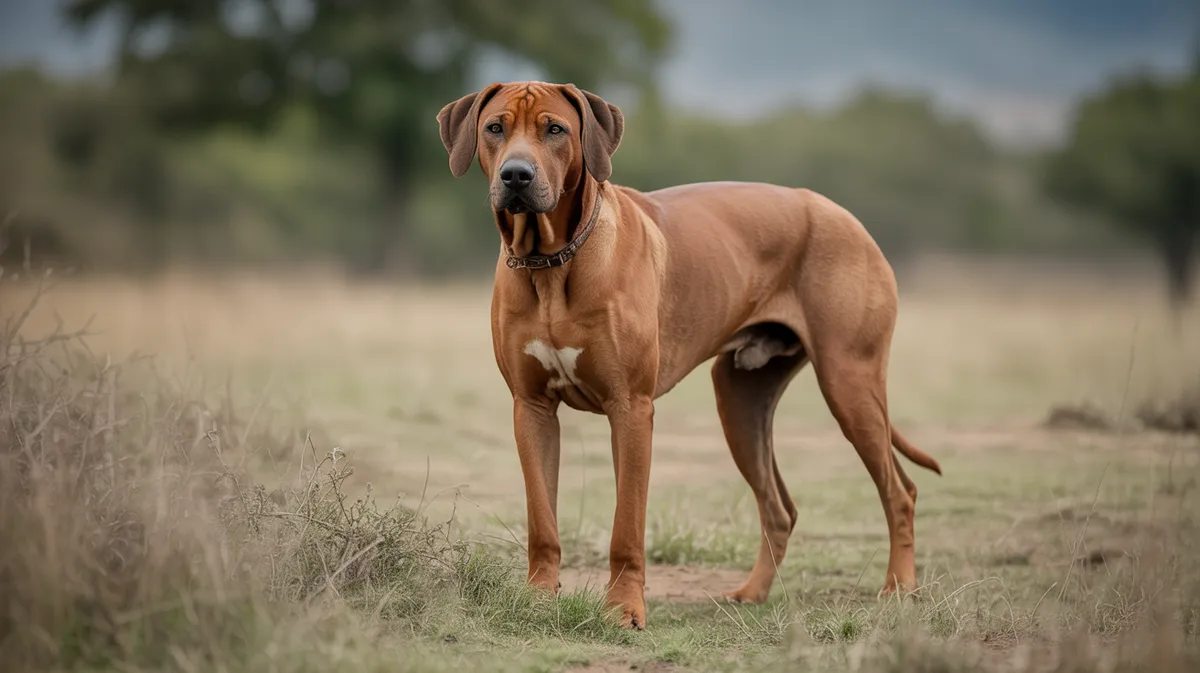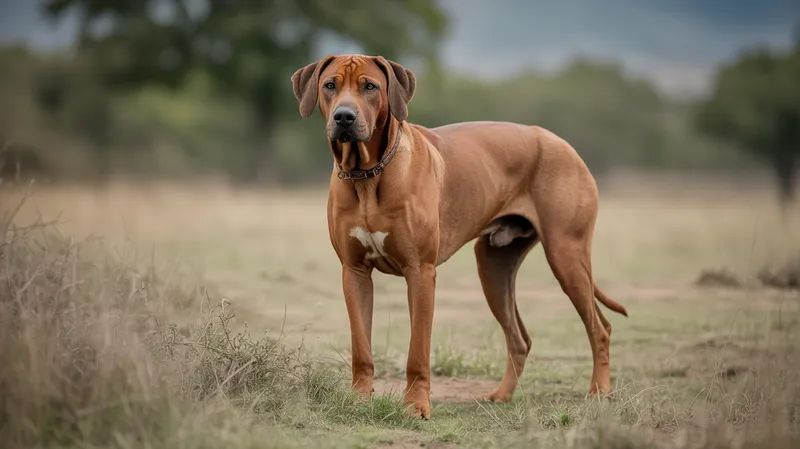
Rhodesian Ridgeback
Canis lupus familiaris

Meet the Rhodesian Ridgeback
The Rhodesian Ridgeback is a large, athletic breed of domestic dog originally bred in southern Africa for hunting and guarding purposes. Recognizable by the distinctive ridge of hair along its back that grows in the opposite direction from the rest of the coat, this breed is both powerful and agile. Ridgebacks are known for their loyalty, intelligence, and independence, making them excellent companions for active families. Their short, sleek coat requires minimal grooming, and their dignified demeanor is balanced by an affectionate nature with their owners.
Classification
Mammal
Habitat
Savanna and grassland regions near human settlements
Diet
Omnivore
Lifespan
10-12 years
Conservation
Least Concern
Weight
29-41 kg (64-90 lbs)
📖Fascinating Facts
Lion Hunters
Rhodesian Ridgebacks were originally bred in southern Africa to track and help corner lions, earning them the nickname 'African Lion Hound.'
Unique Ridge
The breed’s hallmark ridge of hair running along its back is caused by a specific genetic mutation and is a defining feature of the breed standard.
Endurance Athlete
Rhodesian Ridgebacks possess impressive stamina and speed, making them excellent companions for runners and outdoor enthusiasts.
📋Detailed Description
The Rhodesian Ridgeback is a robust, muscular breed, typically standing 63–69 cm (25–27 in) at the withers and weighing 29–41 kg (64–90 lbs), with males generally larger than females. Its most distinctive anatomical feature is the 'ridge'—a strip of hair along the spine growing in the opposite direction to the rest of the coat, caused by a genetic mutation (the Ridge gene, FGF3/FGF4). The breed has a deep chest, strong limbs, and a long, tapering tail, all contributing to its endurance and agility. Ridgebacks possess a keen sense of smell and acute sight, adaptations for tracking and hunting large game. Their short, dense coat is typically light wheaten to red wheaten in color, sometimes with small white markings on the chest and toes. Behaviorally, they are intelligent, independent, and can be reserved with strangers but are deeply loyal and affectionate with their families. Socially, Ridgebacks are pack-oriented, often forming strong bonds with other dogs and humans. They are known for their high stamina and athleticism, requiring regular exercise and mental stimulation. Reproductively, the breed matures slowly, with full physical and behavioral maturity often not reached until 2–3 years of age.
💡 Did you know?
Despite their hunting heritage, Rhodesian Ridgebacks are known for being quiet dogs that rarely bark without reason.
🔬Research & Sources
Wikipedia Summary
The Rhodesian Ridgeback is a large dog breed originally bred in Southern Africa. The original breed standard was drafted by F.R. Barnes, in Bulawayo, Southern Rhodesia, in 1922, and approved by the South African Kennel Union in 1927. Its forebears can be traced to the ridged hunting and guardian dogs of the Khoikhoi. These were interbred with European dogs by the early colonists of the Cape Colony for assisting in the hunting of lions. Rhodesian Ridgebacks are known for their protective, yet loyal temperaments.
Last Modified: 5/14/2025
🎭Behavior & Social Structure
Rhodesian Ridgebacks are renowned for their alertness, courage, and self-reliance. Historically bred to track and bay large game, including lions, they exhibit strong prey drive and investigative behaviors. In domestic settings, they are generally calm indoors but highly active outdoors, thriving on structured exercise such as running, hiking, or agility training. Ridgebacks are protective of their territory and family, displaying natural guarding instincts without unnecessary aggression. Social interactions are typically reserved with unfamiliar people or animals, but early socialization can foster a balanced temperament. They are known to be vocal when necessary but are not habitual barkers. Daily routines should include both physical activity and mental challenges to prevent boredom-related behaviors such as digging or chewing. Ridgebacks are also known for their problem-solving abilities and can be independent thinkers, sometimes testing boundaries with their owners.
👶Reproduction & Life Cycle
The Rhodesian Ridgeback exhibits typical canine reproductive patterns. Females generally come into estrus (heat) twice a year. Mating is usually preceded by courtship behaviors such as sniffing, licking, and play. Gestation lasts approximately 63 days (range: 60–65 days), after which litters of 8–12 puppies are common, though litter size can vary. Puppies are born blind and deaf, relying entirely on maternal care for the first two weeks. The dam provides warmth, nutrition, and grooming, with weaning beginning around 3–4 weeks of age. Ridgeback puppies require early socialization and exposure to various stimuli to develop stable temperaments. Sexual maturity is typically reached by 6–12 months, but responsible breeding is recommended only after full physical and behavioral maturity (2+ years) to ensure health and temperament.
🛡️Adaptations & Survival
The Rhodesian Ridgeback's physical adaptations are a direct result of selective breeding for hunting in the harsh climates of Southern Africa. The breed's short, dense coat provides protection from sun and thorns while minimizing overheating. The distinctive dorsal ridge is a unique evolutionary trait, though its original functional significance is debated. Ridgebacks have long, powerful legs and a deep chest, enabling them to cover large distances at moderate speeds and maintain stamina during prolonged hunts. Their acute senses of smell and sight aid in tracking prey. Behaviorally, their independence and intelligence are adaptations for working at a distance from human handlers, making decisions autonomously during hunts. Their reserved, discerning nature likely evolved as a protective mechanism in environments with large predators.
📚Research Sources
🎨Cultural Significance
The Rhodesian Ridgeback holds a prominent place in Southern African history and culture. Originally developed by European settlers in the Cape Colony, the breed was used to track and hold at bay large game, especially lions, earning the nickname 'African Lion Hound.' The Ridgeback is a symbol of resilience and adaptability, reflecting the challenges of colonial life in Africa. In modern times, the breed is celebrated for its versatility as a companion, guard dog, and show dog. The Ridgeback appears in literature, art, and popular culture as an emblem of courage and loyalty. In Southern Africa, it is a source of national pride, with breed clubs actively preserving its heritage and promoting responsible ownership.
🔬Recent Research & Discoveries
Recent genetic studies have elucidated the inheritance of the dorsal ridge, identifying a duplication involving the FGF3 and FGF4 genes as the causative mutation. Research into dermoid sinus has improved understanding of its link to the ridge gene, informing breeding practices to reduce incidence. Behavioral studies highlight the breed's intelligence, trainability, and suitability for various canine sports and working roles. Ongoing research addresses the breed's predisposition to certain cancers and autoimmune disorders, with international breed registries collaborating on health data collection. Advances in canine genomics continue to inform best practices for maintaining genetic diversity and minimizing hereditary disease.
🎥Wildlife Videos

Rhodesian Ridgeback Pup Unleashes His Hunting Instincts | Too Cute!
These two Rhodesian ridgeback sisters are the best of friends, and tend to leave only boy Rufus out of their games. But when they ...
Animal Planet

RHODESIAN RIDGEBACK - THE LION DOG OF AFRICA
Anneka flies to Cape Town to meet Nicole Gerstenberg of TauTonga Rhodesian Ridgebacks in order to find out everything there ...
Animal Watch

Rhodesian Ridgeback History Depicted.
Ancient pictures briefly showing the early evolution of a fascinating Breed called, 'Rhodesian Ridgeback'.
Daan Catscottage

The Rhodesian Ridgeback: A Lion’s Worst Nightmare?
In the wilds of Africa, a fearless Rhodesian Ridgeback has been captured on camera taking on a fearsome lion. Watch in awe as ...
The Pet Perspective 257k views . 6 hours ago

documentaire rhodesian ridgeback jardin des betes TV Mai 1997
Emission TV "Le jardin des betes" mai 1997; Rhodesian Ridgebacks, Thanda et Lion seal jambo , leur portée, Nyassa Won-Tolla ...
nejemgashaka
🌍Habitat Information
The Rhodesian Ridgeback typically inhabits Savanna and grassland regions near human settlements environments. Rhodesian Ridgebacks have adapted to their environments with specialized features and behaviors.
Primary Habitat:
Savanna and grassland regions near human settlements
More detailed habitat information will be available soon.
🛡️Conservation Status
The Rhodesian Ridgeback is currently classified as Least Concern. Conservation efforts are crucial for preserving this species for future generations.
Common Threats:
- 🏠Habitat loss and fragmentation
- 🌡️Climate change impacts
- 🎯Hunting and poaching
- 🏭Human-wildlife conflict
⚠️Threats & Conservation Challenges
As a domesticated breed, Rhodesian Ridgebacks are not threatened in the wild, but they face challenges related to genetic health and responsible breeding. The breed is predisposed to certain hereditary conditions, most notably dermoid sinus (a congenital neural tube defect associated with the ridge gene), hip and elbow dysplasia, and hypothyroidism. Overbreeding and puppy mills can exacerbate these issues. In some regions, breed-specific legislation or misconceptions about their temperament may limit ownership. Conservation of genetic diversity within the breed is a concern, with breed clubs and registries promoting health screening and responsible breeding practices. Globally, the population is stable, and the breed is recognized by major kennel clubs, but vigilance is needed to maintain health and temperament standards.
🔬Scientific Classification
Scientific Name
Canis lupus familiaris
Classification Hierarchy
🔍 About Taxonomic Classification
Taxonomic classification is a hierarchical system used by scientists to classify and organize living organisms based on shared characteristics and evolutionary relationships.
The system moves from broad categories (Kingdom) to increasingly specific ones, with each animal's scientific name typically consisting of its Genus and species.
📝Community Notes
Share your observations and insights about the Rhodesian Ridgeback with our community of wildlife enthusiasts.
Join Our Community
Sign in to share your observations and connect with fellow wildlife enthusiasts.
Sign In to ContributeNo community notes yet
Be the first to share your observations about the Rhodesian Ridgeback!
Explore Rhodesian Ridgeback
Select a tab above to learn more about this amazing animal.
📸Photo Gallery
No photos available for this animal yet.
🌟Discover More Wildlife
Continue your journey of discovery with more fascinating animals from our database
